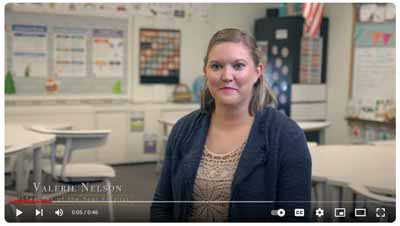Valerie Nelson
Kindergarten, Chamberlain Elementary School, Chamberlain

What made you decide to go into teaching?
I’ve wanted to be a kindergarten teacher since I was in first grade. I went through school in Ipswich, and I had a friend whose mom was our second grade teacher. So I would spend my after school time playing teacher in Mrs. Bowers’ room all through elementary with my friend Melissa.
I fell in love with teaching school. When I got older, I started babysitting, then I kept working with kids through high school, in different jobs and volunteering opportunities.
I knew early on – I never had another desire. I’ve loved it ever since.
What is the best part of teaching?
I think the best part of teaching is being able to give students an education. An education is something no one can take away from them. You can just make it a positive experience and build relationships with them.
What’s the most challenging part of teaching?
All the dynamics of the classroom, especially when it comes to the different skill sets of the kids – academically, socially, behaviorally. It’s trying to meet each child where they’re at and giving them the skill set they need to be successful.
Why is kindergarten such an important year?
The kindergarten teacher sets the standards and expectations for the rest of their time at school. You can make or break their desire to learn in kindergarten.
If you could go back in time and give yourself some advice at the start of your career, what would that advice be?
Don’t be afraid to ask for help. Teachers love to help others. I think we go into it thinking we’re on our own.
I had some amazing cooperating teachers when I started. Everything I know now is from all the past teachers who worked with me, and the experience they had. It’s important for new teachers to rely on those other teachers. There’s so much knowledge in a school district, and it’s important to use that.
Do you have any, “it’s weird but it works” teaching strategies?
I’ll have parents stop in, and they always say, “I don’t know how you do this.” I think the biggest thing is, you really have to focus on being able to see the miracles when they happen in the classroom. If you don’t believe in miracles, you should come to a kindergarten classroom.
For example, the student who shows up on the first day of school and doesn’t know how to write his name, and by the end of the year, he’s my best reader. You see them grow so much in just a year in kindergarten, and you see those miracles every day if you look for them: they made a good choice today. Instead of having a meltdown, they fought the urge to fall apart, and they went back to their seat. I can see it in them, that they don’t want to go back to their seat, but they get control of themselves, and they make the right choice without being told.
So what works is to build on the relationships in the classroom and concentrate on those miracles.
You’ve been teaching for 16 years; what’s one thing that has stayed constant over the years?
Kids’ desire to learn – that has not changed. As a kindergarten teacher, I feel that every child has a desire to learn. They want to be there. Once they start to learn things, their smile brightens up, and they light up – that hasn’t changed.
